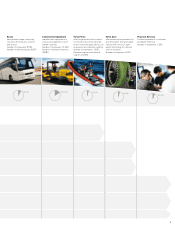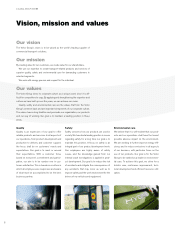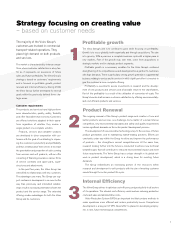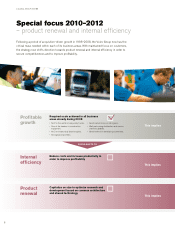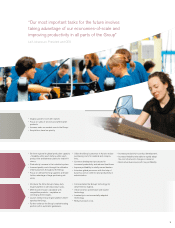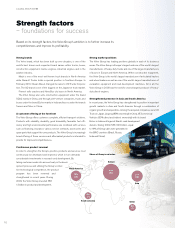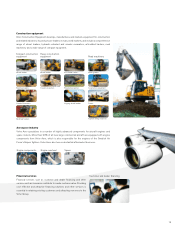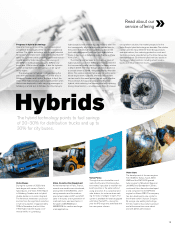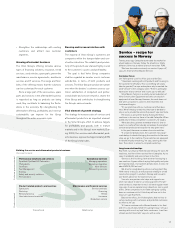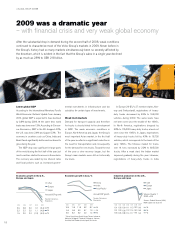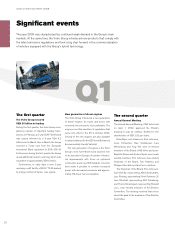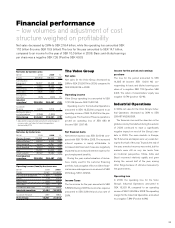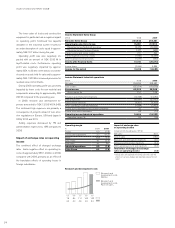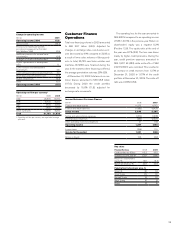Volvo 2009 Annual Report Download - page 19
Download and view the complete annual report
Please find page 19 of the 2009 Volvo annual report below. You can navigate through the pages in the report by either clicking on the pages listed below, or by using the keyword search tool below to find specific information within the annual report.
Volvo Buses
During the summer of 2009, eld
tests began with seven of Volvo's
hybrid buses, one Volvo 7700 Hybrid
in Göteborg, Sweden and six hybrid
double-deckers in London, England.
The eld tests have been successful
and conrms the signicant reduction
in fuel consumption of approximately
30%. In November, the rst Volvo
7700 Hybrid started regular, com-
mercial trafc in Luxemburg.
Volvo Construction Equipment
At the Intermat fair in Paris, France,
several new models were introduced,
among them the ECR305CL short-
swing excavator and the medium-
sized wheel loaders L45F and L50F.
Later in the year, a new generation of
road machinery was launched; in it
the pavers ABG7820B and
ABG8820B for medium and large-
scale applications.
Volvo Penta
Through the use of satellite coord-
inates the Dynamic Positioning Sys-
tem makes it possible to maintain the
boat's position in the water without
using an anchor. It is a practical and
safe feature, for instance when wait-
ing for locks or bridges to open. The
system is available for boats equipped
with Volvo Penta IPS – during the
year the IPS range was extended with
two new power classes.
Volvo Aero
The development of the new engines
Trent XWB for Airbus future A350
XWB and the PW1000G geared
turbo engine for Mitsubishi Regional
Jet (MRJ) and Bombardier CSeries
continued. Volvo Aero also developed
a vital component to the GP7000
engine for Airbus A380. The company
has also developed a new nozzle for
the Ariane rocket’s Vulcain 2 engine.
By using a new welding technology,
the new nozzle is less costly to produce
and at the same time more robust
and with better performance.
The hybrid technology points to fuel savings
of 20–30% for distribution trucks and up to
30% for city buses.
Read about our
service offering
Progress in hybrid technology
Hybrid technology is one of the most promising and
competitive technologies of the future for commercial
vehicles. The hybrid technology, with its large potential
for saving fuel, means lower costs and increased prot-
ability for customers while providing substantial environ-
mental benets. Tests have shown fuel-savings of
20–30% for distribution trucks, up to 30% for city
buses and 10% for wheel loaders. If also the hydraulic
system is hybridized, the fuel savings can be signi-
cantly higher.
The development of hybrids continued during the
year with hybrid buses starting to roll in eld tests in
Göteborg, Sweden and London, England. In April, the
Volvo 7700 Hybrid city bus had its world premier, when
the bus was deployed in trafc carrying passengers in
Göteborg in a eld test. In October, the Volvo Group’s
hybrid projects took another big step forward, when the
rst commercially sold hybrid bus was handed over to
the customer Sales-Lentz in Luxemburg. Also on the
truck side, development continues with hybrid refuse
trucks in eld tests in Göteborg, Lyon, France and New
York, USA.
The Volvo Group has been testing various types of
hybrid solutions since the 1980s and Volvo unveiled the
rst commercially viable hybrid solution for heavy vehicles
in March 2006. The Volvo Group’s solution is based on
a concept known as I-SAM – Integrated Starter, Alternator
Motor. This solution entails that an electric motor and a
diesel engine work in parallel, whereby each of them
can be used in the areas where they are most effective.
This increases the capacity compared with series
hybrids, while reducing fuel consumption and improving
driving characteristics – simultaneously. Since it is based
on a platform solution, the market prospects for the
Volvo Group’s hybrid technology are favorable. The solution
can be used for many different Volvo Group products
and applications, thus reducing production costs and
facilitating volume manufacturing. The Volvo Group has
developed about 20 different hybrid vehicles based on
the Group’s hybrid solution, including wheel loaders,
buses and refuse collection trucks.
Hybrids
15


